The 1980s were a golden age for Doctor Strange, who appeared in multiple titles with excellent writing and fantastic surrealist art. In fact, the sheer abundance of appearances in this period can make a collector’s task a little daunting, so here we’ll provide some order to the material, touching on some major story arcs so you’ll know which issues are important to own, and get a feel for the type of storytelling from this period.
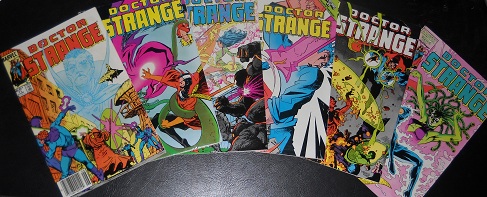
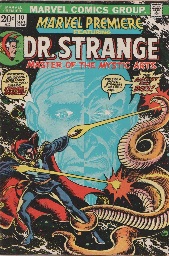 A former surgeon who lost the skill of his hands in a car accident, Stephen Strange discovered spiritual enlightenment and extraordinary magical power, enabling him to ward off Lovecraftian monsters and roam across bizarre dimensions, either mentally with the all-seeing Eye of Agamotto, or floating physically with his Cloak of Levitation. The quaint diction of his rhyming spells and the crazy surrealist visuals of Steve Ditko and his successors were a striking departure in mood from the sci-fi in most comics since the sixties. This was a return to pulp horror, where anything could happen. In Marvel Premiere No. 8-10 (1973), Dr. Strange took over the mantle of Sorcerer Supreme from his mentor the Ancient One. He was thenceforth responsible for defending Earth’s dimension, not from physical threats, but from unseen horrors of the mind and spirit.
A former surgeon who lost the skill of his hands in a car accident, Stephen Strange discovered spiritual enlightenment and extraordinary magical power, enabling him to ward off Lovecraftian monsters and roam across bizarre dimensions, either mentally with the all-seeing Eye of Agamotto, or floating physically with his Cloak of Levitation. The quaint diction of his rhyming spells and the crazy surrealist visuals of Steve Ditko and his successors were a striking departure in mood from the sci-fi in most comics since the sixties. This was a return to pulp horror, where anything could happen. In Marvel Premiere No. 8-10 (1973), Dr. Strange took over the mantle of Sorcerer Supreme from his mentor the Ancient One. He was thenceforth responsible for defending Earth’s dimension, not from physical threats, but from unseen horrors of the mind and spirit.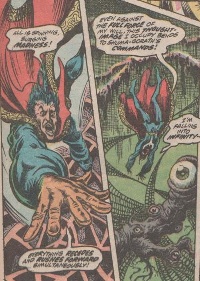
The much-maligned 1978 TV movie actually gets some important aspects of Dr. Strange right. In fact, it did too good a job of portraying the occult and diabolical, so that it was denounced by some citizens’ groups. (In fairness, there’s a part where Asmodeus is summoned!) A nice touch was making Stephen Strange a psychologist rather than a surgeon, since Doctor Strange excels in psychological realism, blurring the line between mind and spirit. More than a few writers have hinted that his mystical battles are really of the mind.
Doctor Strange entered the 80s with his own bimonthly title and as the leader of the secret team known as the Defenders, who usually included the Incredible Hulk, Valkyrie, and Nighthawk, though there was no telling who Doc would summon. The Defenders deserve a separate discussion, but Doctor Strange fans should definitely take a look at Defenders Vol. 1, No. 90-125. These can be acquired cheaply in the Marvel Essential paperbacks of The Defenders, Vol. 4-6.
The Doctor Strange solo title (Vol. 2) runs from No. 39 in February 1980 and culminates in two major story arcs in No. 70-74 (1985) and No. 75-81 (1986-87). These are important background for the late 80s titles.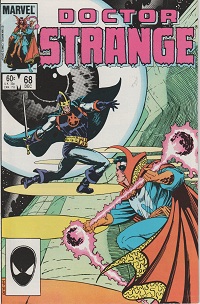
Having cured the Black Knight of madness (No. 68), Dr. Strange finds that he is being attacked for no apparent reason by Umar, sister of Dormammu, who succeeded the latter as ruler of the Dark Dimension. Dr. Strange’s disciple Clea had returned to her native dimension to organize a rebellion against Umar’s rule, and the queen supposed Strange was involved.
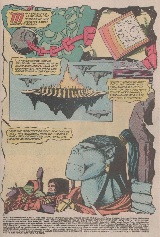 When Dr. Strange decides to sneak into the Dark Dimension and assist the rebels, we are treated to a great story that reveals the origin of Dormammu’s rise to power and shows fantastic mindscapes of the Dark Dimension. To leave or enter their hideout, the rebels have to traverse the mystic prison of the ever-warring Mindless Ones. Clea uses her knowledge of Earth pop culture for secret passwords, from “Yo Adrian” to “The Pepsi Generation.” This being the 80s, it’s no spoiler to say that the good guys win, but in the process we learn something unsettling about Clea.
When Dr. Strange decides to sneak into the Dark Dimension and assist the rebels, we are treated to a great story that reveals the origin of Dormammu’s rise to power and shows fantastic mindscapes of the Dark Dimension. To leave or enter their hideout, the rebels have to traverse the mystic prison of the ever-warring Mindless Ones. Clea uses her knowledge of Earth pop culture for secret passwords, from “Yo Adrian” to “The Pepsi Generation.” This being the 80s, it’s no spoiler to say that the good guys win, but in the process we learn something unsettling about Clea.

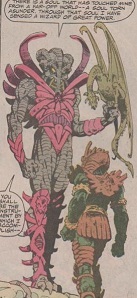 This theme of the hero having to lose something in order to prevail will be repeated, to greater extremes, in later Doctor Strange stories. In the final story arc of his title (No. 75-81), Doctor Strange must destroy all of his mystic talismans and scrolls in order to save his friends and the world from Urthona, a would-be usurping Sorcerer Supreme from a distant galaxy. Worse, he is forced to kill a human host and to use black magic.
This theme of the hero having to lose something in order to prevail will be repeated, to greater extremes, in later Doctor Strange stories. In the final story arc of his title (No. 75-81), Doctor Strange must destroy all of his mystic talismans and scrolls in order to save his friends and the world from Urthona, a would-be usurping Sorcerer Supreme from a distant galaxy. Worse, he is forced to kill a human host and to use black magic.
This sets the tone for a darker, more conflicted Dr. Strange in Strange Tales Vol. 2 (19 monthly issues, 1987-88, shared with Cloak and Dagger). What saves this series from being nihilistic is that Dr. Strange never delights in using black magic, though he finds himself forced by circumstances to compromise his prized purity in order to protect his world. He resists this necessity and tries to forestall it, even making his friends forget him. Ultimately, he must make an alliance with the Ancient One’s old enemy in order to face and defeat an even greater threat (but not before losing an eye in No. 10).
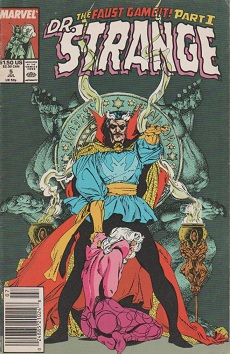 Some semblance of normalcy is restored in the subsequent monthly series, titled: “Dr. Strange: Sorcerer Supreme” (1988-96) A more athletic Stephen Strange returns to his white-magic ways with the help of his friends and restored talismans. Serious havoc is wrought, however, by his old rival Baron Mordo in “The Faust Gambit” (No. 5-8, 1989) and “The Dark Wars” (No. 21-24, 1990). The latter miniseries has a feature on “Legends and Lore of the Dark Dimension.”
Some semblance of normalcy is restored in the subsequent monthly series, titled: “Dr. Strange: Sorcerer Supreme” (1988-96) A more athletic Stephen Strange returns to his white-magic ways with the help of his friends and restored talismans. Serious havoc is wrought, however, by his old rival Baron Mordo in “The Faust Gambit” (No. 5-8, 1989) and “The Dark Wars” (No. 21-24, 1990). The latter miniseries has a feature on “Legends and Lore of the Dark Dimension.” 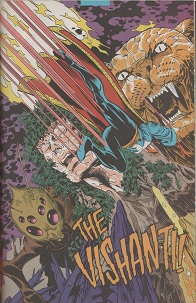 Later, we get a glimpse of the oft-invoked, seldom seen Vishanti (“Demon’s Debt,” No. 48, 1992) The Vishanti were first identified in the 80s (Doctor Strange, Vol. 2, No. 49) as omnipresent Oshtur, all-seeing Agamotto, and Hoggoth, he of the “hoary hosts.” Earlier mentions in spells implied the Vishanti were distinct from these beings.
Later, we get a glimpse of the oft-invoked, seldom seen Vishanti (“Demon’s Debt,” No. 48, 1992) The Vishanti were first identified in the 80s (Doctor Strange, Vol. 2, No. 49) as omnipresent Oshtur, all-seeing Agamotto, and Hoggoth, he of the “hoary hosts.” Earlier mentions in spells implied the Vishanti were distinct from these beings.
The 80s Doctor Strange is also responsible for sending an out-of-control Hulk to the interdimensional Crossroads, setting up one of the strangest, most creative Incredible Hulk storylines. But that’s for another time.